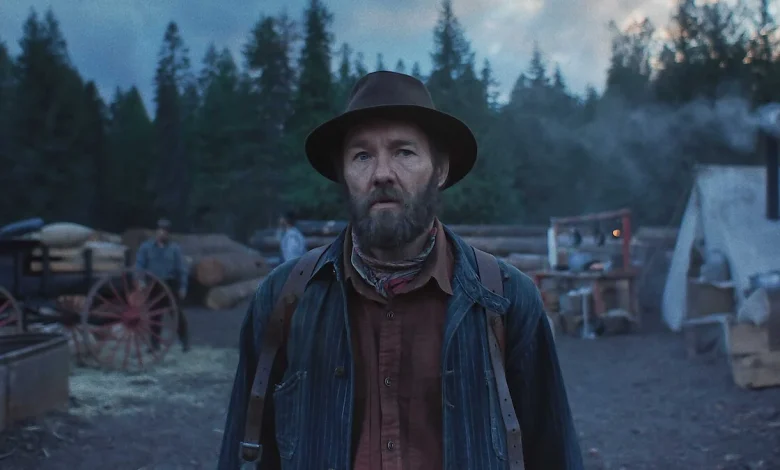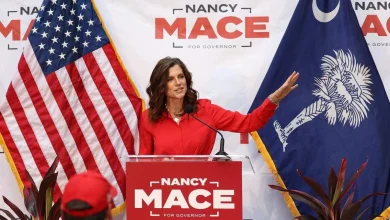Bryce Dessner’s Train Dreams Score Explores the Sounds of Nature

Clint Bentley’s Train Dreams tells the story of one man’s life; that man is Robert Grainier (Joel Edgerton). He is as taciturn as he is resolute as he moves through his days as a logger and railroad worker in the Pacific Northwest in the early 20th century. Grainier might not speak much, but it’s clear that his feelings run deep, as he lives through love and loss, joy and grief — the extraordinary experiences of an ordinary life. This is all against a breathtaking background of towering trees and an emotionally resonant score by composer Bryce Dessner, whose music encapsulates a wide range of feelings that might otherwise be impossible to articulate in words.
For Dessner, who has worked on prior films with Bentley, like Jockey, writing the score felt like tapping into something profound and meaningful. This was reflected in the cinematography by Adolpho Veloso; the screenplay, adapted by Bentley and Greg Kwedar from Denis Johnson’s novella; and the acting, with a cast that includes Edgerton, Felicity Jones, Kerry Condon, and William H. Macy.
“There’s a German painter, Anselm Kiefer, who says something like, ‘There’s no such thing as an innocent landscape,’ ” says Dessner. “With this film, it feels like the landscape itself is full of information. It’s like it’s full of emotion, and even the light is full of emotion, as are the performances of the actors — the way they inhabit the screen. All that makes it feel really wonderful to participate in a project like this.”
In addition to the score, Dessner wrote and performed an original song for the film with musician Nick Cave, also called “Train Dreams.”
“We talked a lot about a song for the end of the film, and Clint and I both felt Nick Cave would be amazing to collaborate with,” Dessner says. “I was sitting in Paris with my family one day and got a call from Nick saying he loved the book and the film and would love to collaborate on a song. Nick is one of our longtime heroes and a huge influence, and it was such an honor to get to work with him. He very graciously asked me to send him ideas for the song. And I sent some music of mine that Clint and I loved for the tone of the ending as an idea to start the conversation. Nick beautifully wrote his lyrics and melody over the idea I had sent him, adding more layers and instruments in the studio.”
Below, Dessner talks about his long relationship with Bentley and Kwedar, using instruments from the early 20th century to record the score, and what it was like to compose music for the film’s climactic fire scene.
Gonzalo Marroquin/Getty Images for Netflix
How did you come to work on Train Dreams?
Bryce Dessner: Clint Bentley and Greg Kwedar are old friends of mine. This is the fourth film of theirs I’ve worked on. The first one was Transpecos, and then Jockey, and Sing Sing last year, so we have an ongoing collaboration. I met them as young directors shortly after I did The Revenant, and they were big fans of [Alejandro G.] Iñárritu and approached me about working with them.
It’s really wonderful to have that kind of trust and confidence with artists, where they really give me a lot of range to work on these things. It’s one of my favorite types of projects to do.
How do you think your prior collaborations with them affected how you approached this project?
Dessner: I think Clint and Greg make really beautiful, small films that are extremely well-written and fully conceived, so that it’s rare that they’re asking for music to solve a problem. It’s more that they’re dreaming in a bigger way to allow music to really add something, a kind of poetry, to the film. There’s that sense of trust, where they really understand how I work and love what I do. The admiration is mutual.
So there’s always a possibility of trying things or taking risks in their films that maybe in some other projects I’ve done, I would feel less comfortable doing — because often, you’re trying to satisfy the opinions of many people in the room. Each film is different, but I think these are really wonderful projects to work on. And in the case of Train Dreams, there’s a lot of room for music.
The sweep of the forest, the sense of the earth were really important for me in the music.
Bryce Dessner
Were you familiar with Denis Johnson’s book before this project?
Dessner: I saw [Clint and Greg] long before they shot the film, and they brought me the book, so I read it before they shot the film. It’s rare as a composer to be involved at that level, where you’re really seeing the script and even the dailies and all the treatments for where they were going to shoot it. Because we’re friends, I was in the room with them for a lot of that discussion. And they have a similar relationship [as they have with me] to their cinematographer and their editor and their sound designer, so there’s a real group of us now who have worked on these films.
And Denis Johnson … yeah, I read the book and loved it — it’s really a great American novel, and that very much speaks to me. So I was able to start thinking about music immediately.
I should also say that I saw Denis Johnson read once — some short stories. A long time ago, we were invited to play one of our first concerts as the National [Dessner’s band] in Buffalo, probably in 2000. It was an event at which Denis Johnson read, so there’s an old connection as well to him as a person, which is quite interesting.
He was such an incredible artist — as a novelist and a poet. Train Dreams is such an American novel, set in such a specific time. How did the film’s setting influence your work?
Dessner: I tried a different approach to this film. I began in old analog recording studios with old instruments in them — parlor pianos and banjos and ukuleles and organs and pump organs or harmoniums, instruments that might’ve been from the early 20th century into the mid 20th century, that period of the American West. All that music — American folk music — was on my mind.
At the same time, I was also thinking about orchestral music from that period, in the way that strings and texture could blend in an organic way. But also there’s a kind of epic [quality to] the cinematography in this film and the sense of nature.
I wanted to explore all those sounds and the poetry of the filmmaking. Also, a lot of it is silent; a lot of the film has very little dialogue. It’s very much immersed in the environment so that just the sweep of the forest, the sense of the earth were really important for me in the music.
I was so inspired by the material and the images. I composed a suite of Train Dreams pieces inspired by the film, including some of the main themes that I wrote off picture; I wrote them even before I’d seen the film. In that way, I would say the music for this project resembles more closely what I do in a concert hall.
When you were able to watch the movie, did it reinform some of the pieces you had written off picture?
Dessner: Most of them got altered and added to. Some of them, though, stuck.
There was a suite of themes that I was working on that was the music that came to me when I was thinking about Train Dreams. You can do that ahead of time, but the picture always has other things to say. I would get assemblies that were not the full film, but parts of it, and then, essentially, when I had the whole [film], I started really composing to the picture.
That’s all musical for me — the sound of the train, the sound of the nature — all that feels really informative.
Bryce Dessner
What was it was like to compose for the fire scene? What do you keep in mind for a scene that is so visually, emotionally, and auditorily overwhelming? How do you balance the score with what’s happening onscreen?
Dessner: I think one interesting thing about these projects is the group [that’s working on it with you] — there’s the editor, the director, and the sound designer, Parker Laramie. He’s in the room with them. And so there’s a lot going on sonically in that moment of creating the sound of the fire. That’s all musical for me — the sound of the train, the sound of the nature — all that feels really informative.
The intense emotional energy of that moment and sense of loss, which is such a human feeling, was increased because [my work on the score] was going on during the fires in California. That was around that time.
I was thinking about composers like [György] Ligeti — not really film music, to be honest. The music itself has this very ambitious, very orchestral, very layered feeling about it — it’s sliding out of control, but then there’s a melodic undertone that enters as [Robert Grainier] starts to realize what’s happened. [It’s a] kind of passacaglia, like something you might almost hear in Mozart’s Requiem, a descending line that underpins his loss. It was an ambitious moment to score. There’s no dialogue for the musicist to tell the story.
What was it like to see the film as a whole for the first time?
Dessner: This film, it feels quite quickly that the magic is there — especially in the cinematography, just how beautifully shot it is. I think it’s the most ambitious of [Bentley and Kwedar’s] films, in terms of the actual artistic line of the visual environment and the way that there’s a lot of space in the film, and it doesn’t feel like it’s chasing a narrative. It’s just taking time with it. So I think it’s quite an achievement. These types of projects are a dream for a composer, where you get to interact with these great artists and use this great source material.
I’ve written a lot of music based on literature. There’s an orchestral piece called “St. Carolyn by the Sea” that’s inspired by Jack Kerouac. In a way, I feel like Denis Johnson is a very interesting, more modern version of that kind of text and nature. It’s like prose, but it has this poetic underpinning.
It feels like we made a piece of art. The process was really collaborative and creative. You can feel that [this project is] in motion, it’s moving, it’s working through itself, and it’s giving time and space to all the elements. I think cinema, when it’s done that way, can be one of the most powerful art forms.
Train Dreams is streaming on Netflix now.





